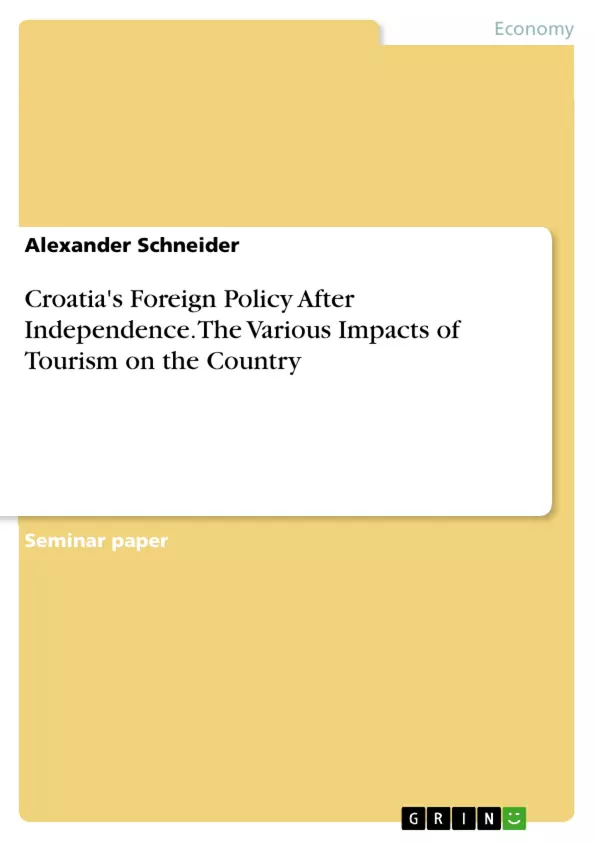The object of this paper is to give the reader a general understanding of tourism on a global scale, continued by a broader overview on the history and development of Croatian tourism from its ancient times over the early 19th century to the perspectives and challenges the country is facing today. Complemented by current statistical data, a comparative report with other travel destinations is further provided.
In the main focus of this paper these tendencies are being followed by a broader theoretical framework of the general impacts of tourism on a travel destination with the focus on economic developments. Consequently, the findings will be then put in disposition, what implications the tourism industry has to Croatia and what measures could help the country for staying competitive in the coming years.
The combined topics of this paper lead us to the following research question: "What effects and challenges has the tourism industry in the case of Croatia and what steps could be implemented in the country in order to maintain a long-lasting positive development for the next decades?"
Moreover, as an outlook for upcoming discussions, various factors will be briefly taken into consideration, in particular, whether the official Tourism Development Strategy until 2020 has born fruits in the last years and if the large financial contribution of tourism to the country's economy can be seen on a long term as a blessing or a curse for this young EU member.
Inhaltsverzeichnis (Table of Contents)
- 1. Introduction
- 2. Global Tourism
- 2.1 Brief historic overview
- 2.2 Theory: General factors and effects of Tourism
- 2.2.1 Most popular International / European travel destinations
- 2.2.2 Total contribution of tourism to International / European economies – GDP's share
- 2.3 General impacts of tourism on a travel destination
- 3. The tourism industry in Croatia
- 3.1 History and Development of Croatian Tourism
- 3.2 Tourist regions in Croatia
- 3.3 Concentration of tourism, types of accommodation and countries of origin
- 4. Analysis: A Critical View on Tourism in Croatia
- 4.1 Factors and effects of tourism in Croatia – Tourism numbers
- 4.2 Impacts of tourism on Croatia
- 5. Tourism Development Strategy until 2020
Zielsetzung und Themenschwerpunkte (Objectives and Key Themes)
This paper aims to provide a comprehensive understanding of the Croatian tourism industry, examining its historical development, current state, and future prospects. It analyzes the global context of tourism, explores the general impacts of tourism on a travel destination, and specifically focuses on the case of Croatia.
- The historical development of Croatian tourism from its ancient origins to the present day.
- The general impacts of tourism on a travel destination, including economic development, cultural influence, and environmental effects.
- The specific effects and challenges of the tourism industry in Croatia, analyzing its strengths and weaknesses.
- The role of the Tourism Development Strategy until 2020 in promoting sustainable tourism growth in Croatia.
- The potential long-term consequences of the significant contribution of tourism to Croatia's economy.
Zusammenfassung der Kapitel (Chapter Summaries)
The introduction provides a concise overview of Croatia's booming tourism industry, highlighting its recent success and the importance of the topic. It outlines the research question and the paper's objectives.
Chapter 2 focuses on global tourism, providing a historical overview of travel motivations and developments from ancient times to the modern era. It then explores the theoretical framework of tourism's general impacts on a travel destination, analyzing factors such as economic contribution and cultural exchange.
Chapter 3 delves into the specifics of the Croatian tourism industry, exploring its history, development, and current state. This chapter analyzes the concentration of tourism, types of accommodation, and the origin of tourists visiting Croatia.
Chapter 4 provides a critical analysis of tourism in Croatia, examining the factors and effects of tourism on the country's economy, environment, and society. It analyzes tourism numbers, discusses the potential benefits and drawbacks of tourism, and explores strategies for sustainable development.
Schlüsselwörter (Keywords)
This paper explores the various impacts of tourism on Croatia, a popular travel destination. It examines the historical development of tourism in Croatia, the global context of tourism, and the theoretical framework of tourism's general impacts on a travel destination. The paper analyzes the concentration of tourism, types of accommodation, and the origin of tourists visiting Croatia. It also discusses the potential benefits and drawbacks of tourism, exploring strategies for sustainable development and examining the role of the Tourism Development Strategy until 2020 in promoting long-term growth in the Croatian tourism industry.
- Arbeit zitieren
- Alexander Schneider (Autor:in), 2019, Croatia's Foreign Policy After Independence. The Various Impacts of Tourism on the Country, München, GRIN Verlag, https://www.grin.com/document/489699



